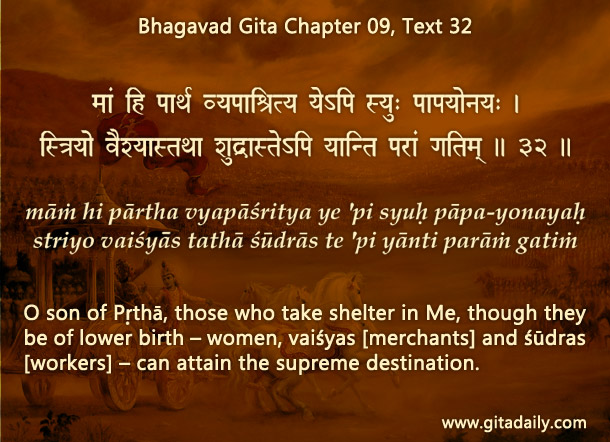The universality of bhakti – Most conventional religious paths present rigid boundaries to differentiate between the pure and the impure, which eventually translates into the qualified and the unqualified. Even in the Vedic tradition, many classes of people who were considered lowborn were not allowed to participate in several rituals that comprised mainstream religiosity in those times.
The path of bhakti-yoga is remarkably inclusive. The Bhagavad-gita states even those who are lowborn can be elevated by practicing bhakti — and elevated all the way to the topmost destination (09.32-33).
Phrased metaphorically, bhakti-yoga is like a mountain elevator that takes people from the bottom of the mountain to the top. The bottom of the mountain is like material consciousness and its top is like spiritual consciousness, specifically consciousness of the topmost spiritual reality, Krishna. The bhakti elevator doesn’t demand any material cost on anyone who wants to get elevated. And it goes down to whatever low level a person might be at and enables them to become elevated.
In today’s egalitarian context, this Gita verse might seem to be based on an objectionable, even outrageous, premise. Why should any classes be given a pejorative-seeming label such as lowborn? First, the reincarnation worldview outlined in the Gita explains that any such label is only temporary and circumstantial and external to our core identity; we are spiritual beings, unaffected by any such labels. Second, the Gita offers a mere nod to the labeling that might have been a part of the social convention of the Gita’s times; it’s thrust is on recommending the path of bhakti-yoga which takes us beyond the limitations imposed by such labelings. Thus, the Gita’s message is egalitarian, in radical contradistinction to the rigid orthodoxy of genealogical labeling that became fossilized as the rigid and discriminatory caste system.
One-sentence summary:
Even if bhakti-yoga nominally acknowledges prevailing social labels such as lowborn, it is essentially a universally accessible pathway to go beyond all such labelings.
Think it over:
- How is bhakti-yoga universal?
- Is lowborn a pejorative label?
- What is the Gita’s attitude toward prevailing social labels?
To know more about this verse, please click on the image


Leave A Comment